Dear reader: This article contains links to products and services that I may be compensated for, at no extra cost to you.
Keelung Night Market (also called Miaokou Night Market) is one of the most famous night markets in Taiwan and by far the most popular of Keelung’s attractions. Many visitors, including myself, say it is their favorite night market in the whole country. Even Anthony Bourdain ate here when he visited Taiwan in 2013!
It’s easy to see why it’s so popular: Keelung Night Market is a short trip from Taipei, easily combined with Jiufen Old Street to make a perfect day trip from Taipei. It is incredibly photogenic, with its rows of yellow lanterns and gorgeous temple at its core. It is a stone’s throw from Northern Taiwan’s largest port, which is especially romantic at night. The selection of foods is vast, including a few famous Taiwanese street foods that originated here. Last but not least, all the market’s stalls are numbered, with their main specialty labeled in Mandarin, English, and Japanese – something you won’t find anywhere else in Taiwan.
I’ve been to Keelung Night Market at least half a dozen times, most recently just prior to Taiwan’s reopening to tourists, so the info below is super recent. In this article, I’ll cover the history of the night market, how to get there, the most famous stalls, and my favorite things to eat at Keelung Night Market.
There’s much more to Keelung that just the night market. You could spend a whole day in the city by following my Keelung visitor’s guide and list of things to to do in Keelung.
And for serious foodies, Keelung Night Market is but 1 of 20 night markets that I introduce in my Greater Taipei Night Market guide.
Table of Contents
History of Miaokou Night Market

Like many night markets in Taiwan, Keelung Night Market grew up around a temple. Temples have long been the focal points of religious events and community gatherings in Taiwan. Food vendors typically set up in front of them to serve attendees. As more vendors set up, they begin lining the streets leading to the temple, and a night market is born.
This is quite obviously the case with Keelung’s night market, as the market’s Mandarin name is Miaokou Night Market, miakou (廟口) meaning “temple entrance” or “temple front”, referring to that area in front of the temple where the food stalls set up. The temple that gave rise to Miaokou Night Market is Dianji Temple (奠濟宮) or more completely, Keelung Dianji Kai Zhang Shenwang (基隆奠濟宮開漳聖王).

Dianji Temple is a Taoist temple with origins going back to 1875 in the Qing Dynasty. At the time, when Tainan was still the capital of Taiwan, Keelung was a part of Taipeh Prefecture and was being rapidly developed. The authorities had recently opened Keelung up as a trading port. The temple was constructed on what was originally a rice paddy.
The temple was devoted to Chen Yuang Guang (who most Taiwanese give the title Kai Zhang Shenwang), a Tang Dynasty general who played an important role in the history of Zhangzhou City in Fujan, the Chinese province where many of Taiwan’s ancestors came from.
Like most old Taiwanese temples, Dianji Temple has been expanded and renovated many times, but there are still a few stone columns dating to the original structure.
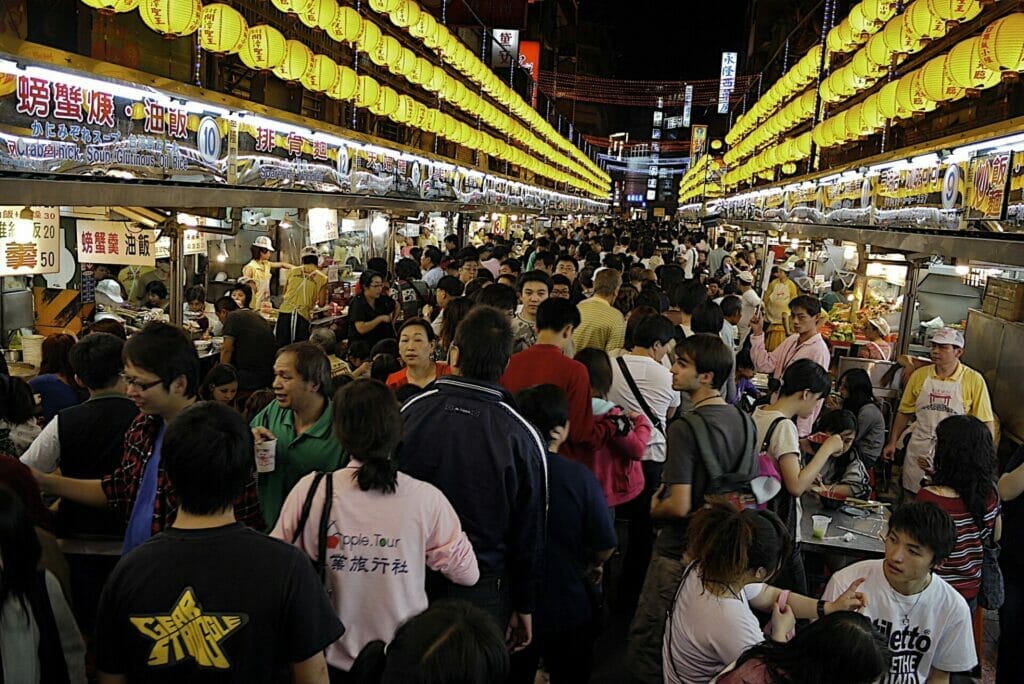
The first food vendors appeared in the small square between the temple’s entrance gate and the temple itself – today, some of the best food stalls can still be found in this courtyard. According to locals in Keelung, the oldest such food vendors date back to around the end of the Japanese colonial period (1945).
Over time, the food vendors accumulated, lining Rensan Road (the road in front of the temple) in both directions. Eventually, the night market merged with another one on Aisi Road, which is perpendicular to Rensan Road, giving Keelung Night Market its present L shape.
In an effort to encourage tourists, picturesque rows of yellow lanterns were added, stalls were numbered, and each stall’s main specialty was denoted above it in English, Japanese, and Mandarin. The strategies worked, and today Keelung Night Market is not only beloved by locals, but also considered a must on many visitors’ Taiwan itinerary.
Also see my guide to Feng Chia Night Market, another of the most famous night markets in Taiwan!
Getting to Keelung Night Market
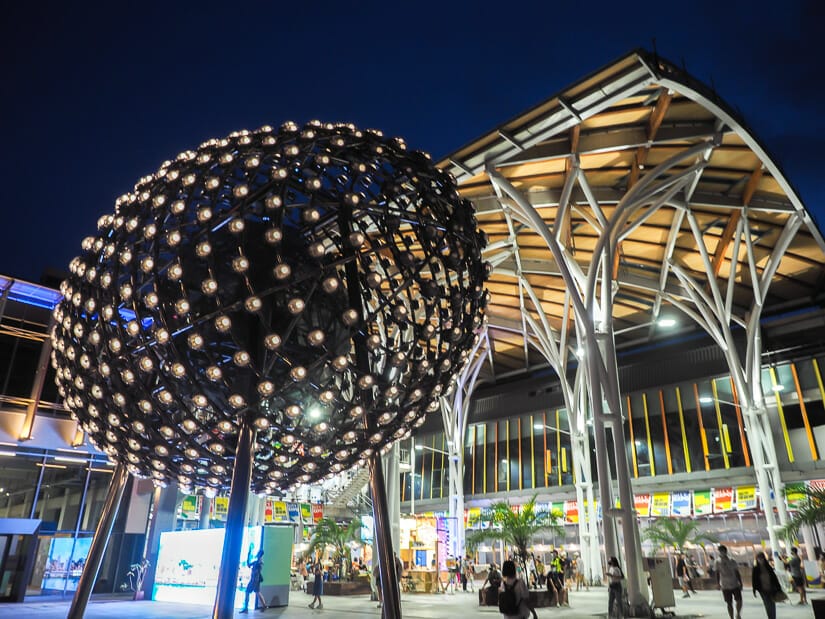
There are several options for getting from Taipei to Keelung Night Market. Expect to spend around an hour to get there. You can swipe your EasyCard for all of the below options – no need to buy a ticket. Here’s my Easy Card guide.
From Taipei Main Station, regular (TRA) trains depart frequently for Keelung, taking 40 to 50 minutes to get there. You could also board the train at Banqiao or Wanhua station (slightly longer ride) or Songshan station (slightly shorter ride).
From Keelung train station, which was totally rebuilt and expanded in 2015, it’s a 10-minute walk to Keelung Night Market via the picturesque and bustling Maritime Plaza on Keelung Harbor.
An even faster way to reach Keelung is by bus. You can take bus 2088 from Taipei City Hall bus station and get off at Taiwan Power Company stop (電力公司站, 25 minutes), which is only 3 minutes from Keelung Night Market. Note that if you arrive by either of these buses, you would then be accessing the night market from the Aisi Road side, rather than the main entrance as I describe in the below tour.
It’s easy to visit Keelung Night Market after a day trip to Jiufen Old Street. From Jiufen Old Street, take bus 788 (heading downhill, bound for Keelung Train Station) for 50 minutes. Get off at Yier Rd. Intersection (Temple Night Market) stop (義二路口), which is only 5 minutes from the night market.
If you decide to spend the night in Keelung, I recommend Drizzle Inn (see on Booking / Agoda). It has dorms and private rooms and is right next to Keelung Night Market.
What to Eat at Keelung Night Market
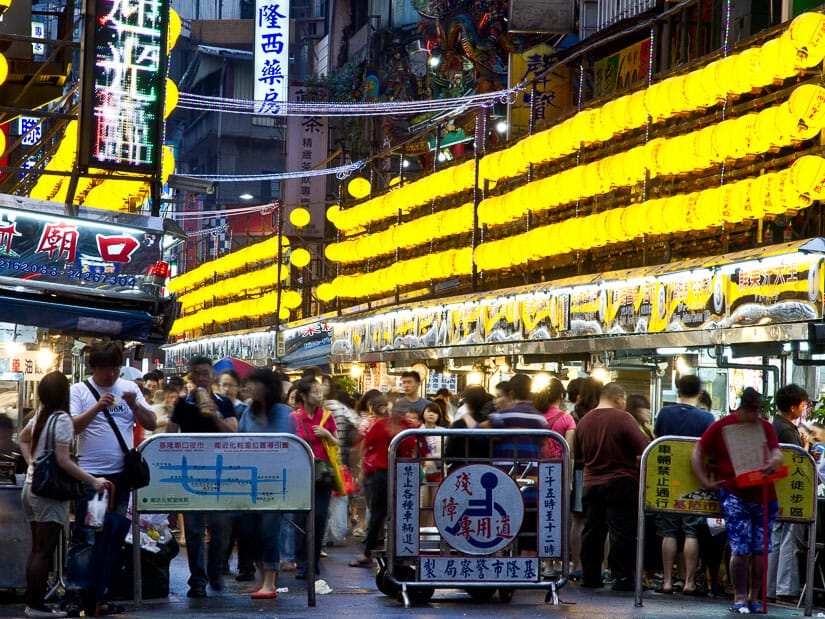
You will need to exercise some control, because there are just so many excellent things to eat at Keelung Night Market.
The following food tour of Keelung Night Market starts from the main entrance, which is at the intersection of busy Aisan Road (愛三路) and Rensan Rd (仁三路, the main street of Keelung Night Market). The famous pictures of Keelung Night Market you’ve probably seen, with all the yellow lanterns, are usually shot from this intersection. The market lines either side of Rensan Road, then turns left on Aisi Road, forming an L shape.
When you enter the night market, all the food stalls on your right will be odd numbers (1, 3, etc.) and the food stalls on your left will be even numbers (2, 4, etc.). I’m not going to introduce every stall (there are too many!), but just the most famous food stalls and ones I like.
I introduce the stalls in the order you will encounter them, so sometimes a lower number appears first. Also note that if you arrive by bus, you might start at the opposite end of the night market, so you can follow this tour in reverse.
If you’re vegetarian or vegan, here are my recommended vegetarian food stalls in this market and others around Taiwan.
#5: Thick Crab Soup (螃蟹羹‧油飯)

A few steps into the market, and on the right side, I highly recommend this delicious thick crab soup (螃蟹羹). The soup (you could call it a stew) is similar to squid stew (魷魚羹), which is very popular and common all over Taiwan, but this one is made with crab meat.
The soup contains mushrooms, fungus, bamboo shoots, and a generous amount of real crab meat. A small bowl goes for NT 70 – it won’t fill you up, but the flavor and texture of the soup are (I dare say) life changing. All the better, because you’ll have stomach space left for other stalls to come.
The stall also sells oil rice (油飯). A carbon-copy stall (#10) sells the exact same two dishes directly across from the original (and more popular) stall. They both have the same name and a similar sign with a crab on it.
#16 Tempura Fried Fish Paste (王記天婦羅)
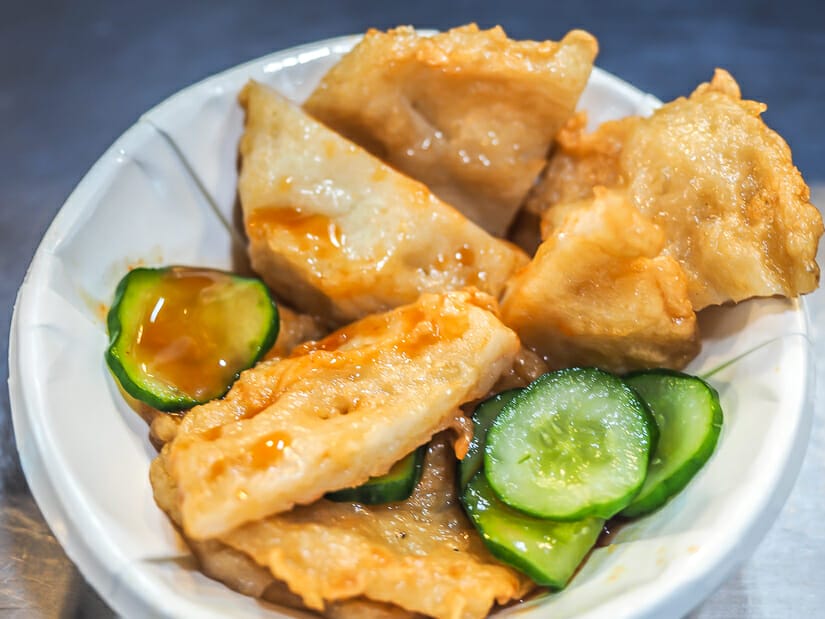
Taiwanese tianbula are fish paste cakes whose name derives from Japanese tempura. Although they are also sometimes called tianfuluo (the Mandarin name for tempura), they are totally different than Japanese tempura (as explained in this Chinese language article). There are many kinds of tianbula, but the most common one in Taiwan comes in round, off-white cakes.
Keelung is known for having some of the best tianbula in all of Taiwan. This popular stall serves these cakes, cut into hunks, lathered in sauce, and served with cucumber slices. Portions are small and only cost NT 30, making for the perfect little treat.
#15: Chicken rolls
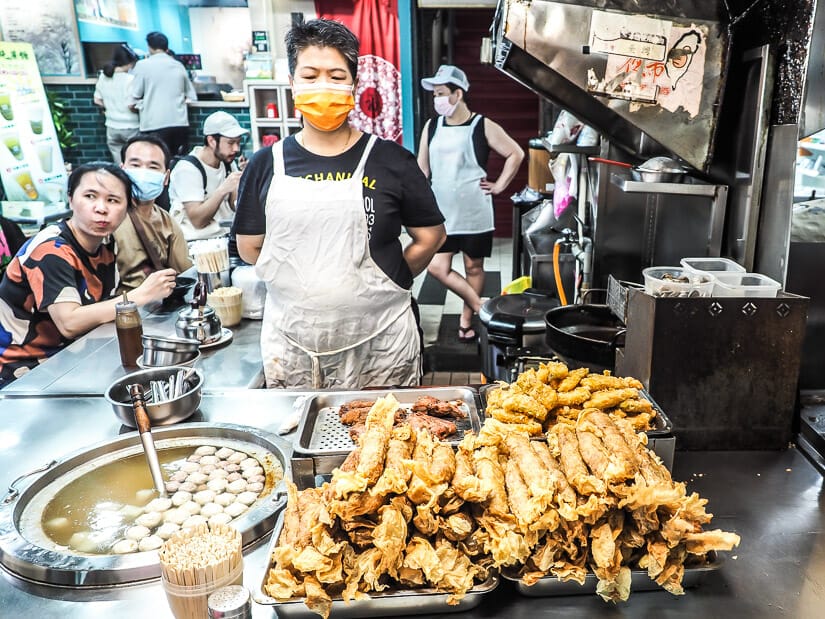
This stall sells several different items, including deep fried fish, fish ball soup, and braised pork rice (滷肉飯 or luroufan), but the main specialty is chicken rolls (雞捲).
These are rolls of chicken meat and vegetable pieces that have been deep fried so that the outer skin is crispy, but the interior is soft. A portion (NT 60) is cut into slices and served on a small plate with sweet and savory sauce.
For vegetarians, there’s a veggie version of this at another stall (see below)!
#22 Pig Knuckles (基隆廟口22號蝦仁羹 豬腳)

Taiwanese can’t get enough of pork knuckles (豬腳), which are dished out at this popular stall on the left. If you’ve never had pork knuckles, the meat is soft and the skin is chewy, which Taiwanese love (unlike German pork knuckles, which are often baked to achieve a crispy exterior).
The knuckles are chopped into pieces and severed with a sauce. The stall also serves thick shrimp soup and braised pork rice.
100-Year Wu Family Ding Bian Cuo (百年吳家鼎邊趖)
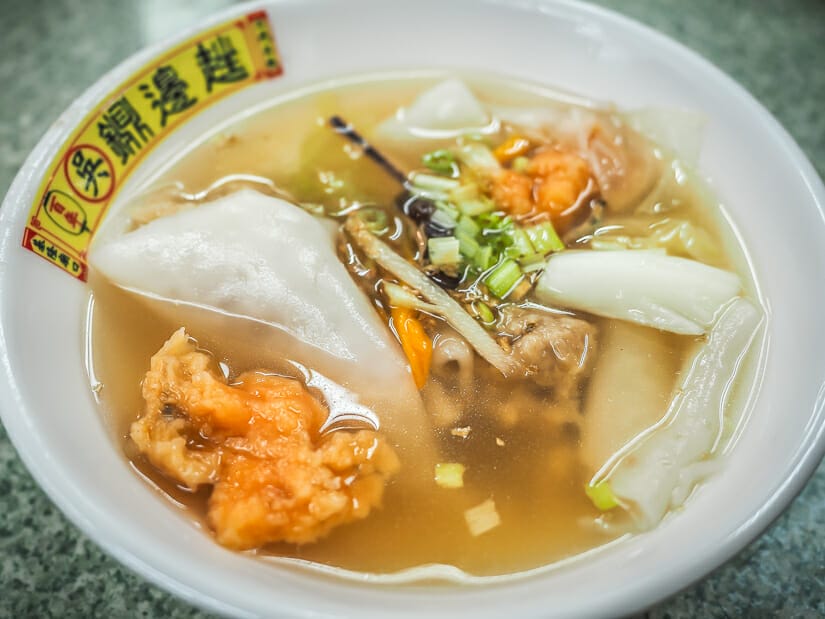
Ding bian cuo (鼎邊趖), literally “pot side paste”, is a specialty of Keelung that has origins in Fuzhou in Fujian province of China. It is made by pouring rice batter onto the side of a wok, then scraping it off to create thick strips of noodle, which are served in a fragrant broth.
This is one of the most famous ding bian cuo stalls in Keelung. The fish-based soup contains yellow lilies (金針), shrimp and meat balls, cabbage, mushrooms, and diced leaf celery for garnish.
Because it is located in the right in the courtyard of Dianji Temple (making it one of the night market’s original food stalls), the stall doesn’t have a number like the ones along the road.
#37: Shen Family Pao Pao Bing (沈家泡泡冰)
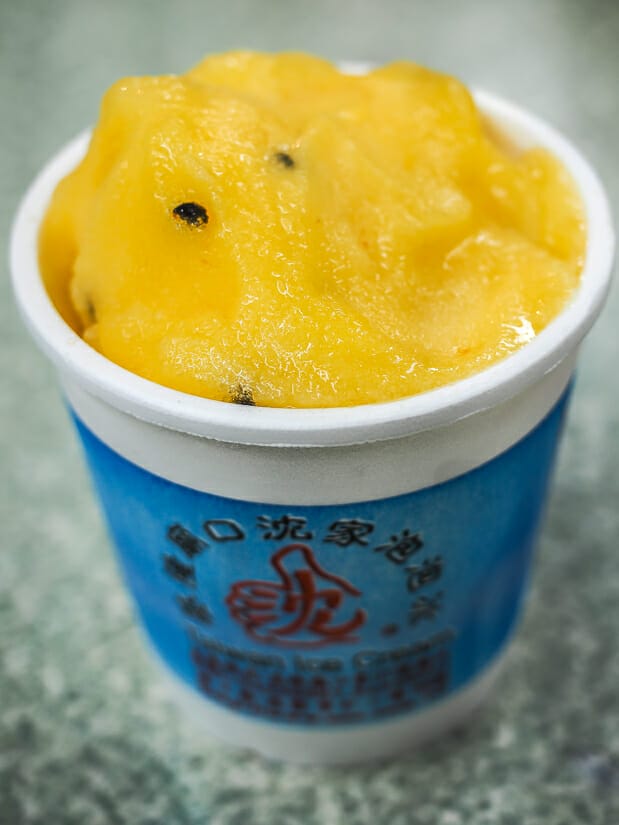
One of the must-tries in Keelung Night Market is Pao Pao Bing (泡泡冰). Invented in Yilan, Pao Pao Bing is essentially Taiwanese shaved iced, but instead of putting the ingredients on top of the shaved ice, they are mixed in for you. It’s similar to traditional Taiwanese ice cream – both are more like sorbet than ice cream.
Shen Family stall serves theirs in a large Styrofoam cup for NT 50 – it’s quite the serving, so you may want to share with a friend. There’s a long list of flavors, including peanut, pineapple, chocolate, smoked plum (烏梅), mango, passion fruit, coffee, corn, and kiwi.
There’s a copycat stall at #41. For vegans, heads up that a small amount of milk may be used in some flavors. It’s best to ask.
#58: Nutritious Sandwich (基隆廟口營養三明治)
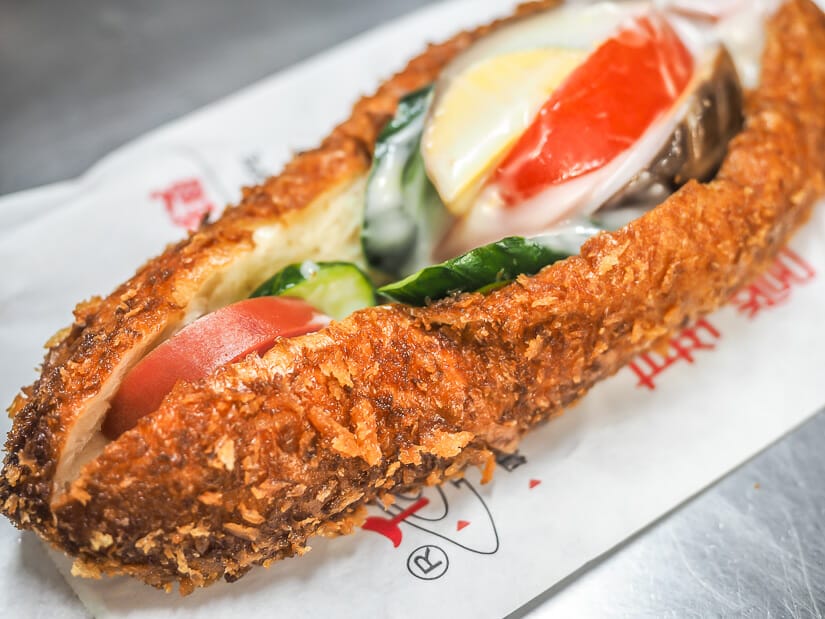
Don’t be fooled by the name. Taiwanese “nutritious sandwiches” (also called “fried sandwiches”), which originated right here in this night market, are anything but nutritious.
Think of these as more like a donut sandwich. They start with a deep-fried donut, slice it open and fill it with tomato, cucumber, spam-like meat, and braised egg (滷蛋 or ludan), then douse it in sweet mayonnaise.
I’ve seen these “sandwiches” all over Taiwan but always avoided them because they seemed off-putting. But alas, I tried one here in Keelung Night Market. And let’s just say, I’m a converted nutritious sandwich lover!
The stall is near the end Rensan Rd., before the night market turns left onto Aisi Rd. Ask for no meat (不要肉 bu yao rou) for a vegetarian version.
#66: Oil Cake and Taro Cake (基隆廟口 油粿 ▪ 芋粿)

While “oil cake” may not sound very appetizing, oil cake and taro cake are actually very traditional savory cakes, not desserts. If you’ve ever had the more well-known Taiwanese dish called radish cake (蘿蔔糕 or luobogao), which is available in almost every Taiwanese breakfast shop, it is quite similar to that.
You’ll see a huge slab of the “cake” on the stall’s counter. The vendor will cut of a few hunks and serve them with sauce and fried shallots.
The stall is one of the last ones on the left side of Rensan road. The same dish can be found at Jiufen Old Street and traditional markets around Taiwan.
#43: One Bite Sausages (世盛一口吃香腸)
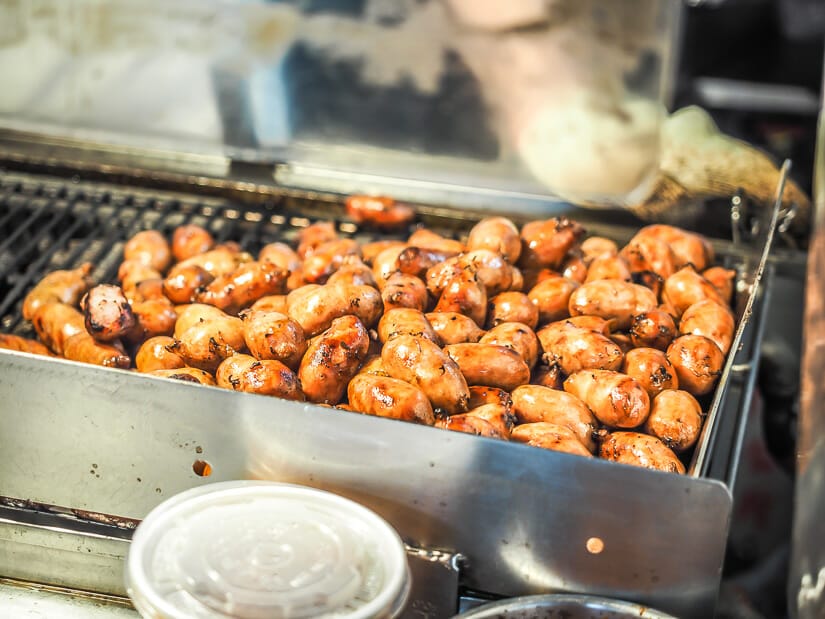
At the end of Rensan Rd., on the corner on the right, is One Bite Sausages. If you’ve never had a Taiwanese sausage (香腸) before, they have a hint of sweetness to them. And here, they come in cute, bite-sized form. And no, they are not testicles.
The mini sausages are NT 8 a piece, jacked up from NT 7 a few years ago. That’s a $0.03 increase. Darn inflation!
#49 Guabao (刈包、四神湯-基隆廟口49號)
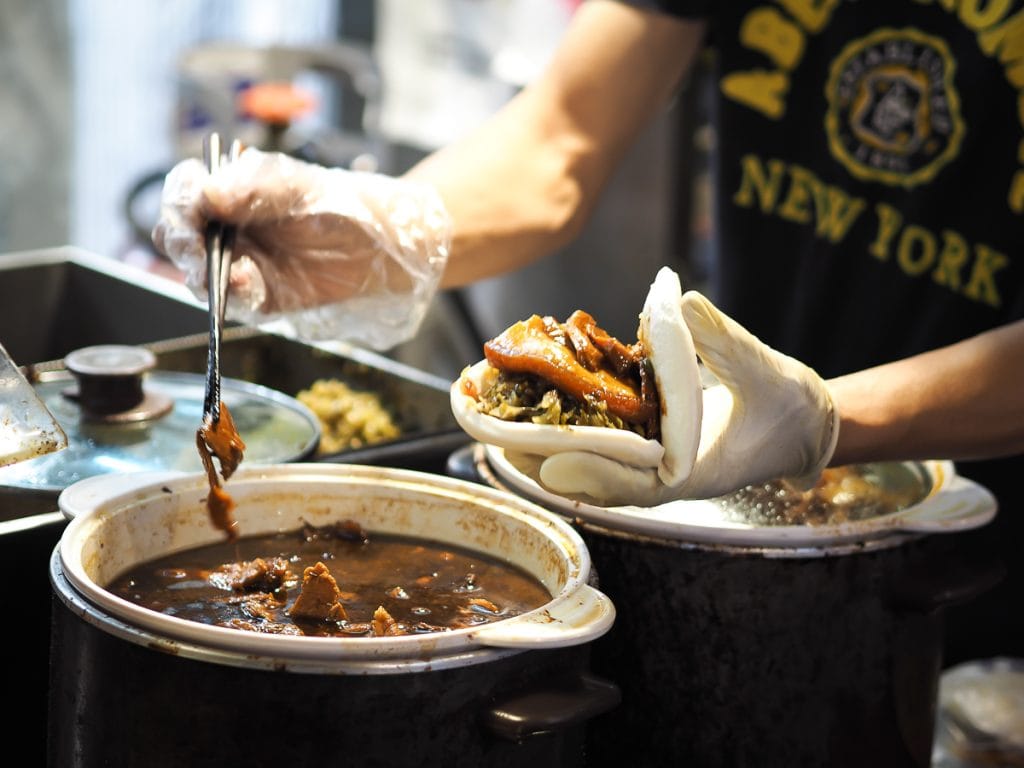
Guabao, also known as the “Taiwanese Hamburger”, is one of the country’s most iconic street foods. This is a great place to try it – Anthony Bourdain did when he visited.
Guabao is a steamed bun filled with a slice of fatty pork and garnished with crushed peanut powder and cilantro. The stall also sells a very traditional dish called Four Treasures Soup (四神湯). It is the night market’s last stall if you turn right on Aisi Road – the remaining stalls are all to the left on Aisi Road.
#70 Crispy Deep Fried Crab (香酥炸螃蟹)
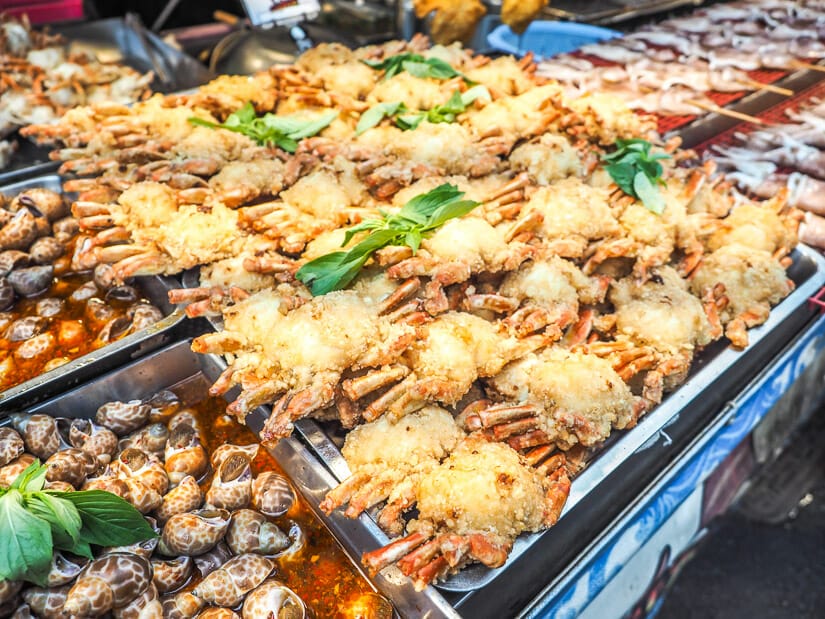
As you turn left down Aisi Road, the second part of the night market, the stalls are no longer numbered. You can’t miss the pile of deep fried crabs on display at the first stall on the left.
I usually bypass crab because I don’t know how to eat it, and there’s hardly any meat. But you don’t have to worry about that here, because you can eat the whole thing!
These whole small crabs are battered and deep fried so their shell becomes edible. It was more delicious than I expected, thanks in part to the salt, spicy powder, and fresh basil added. A single crab goes for NT 70, or 3 crabs for 200. They also have snails and whole squid.
Vegetarian 8 Treasures Glass Noodles (素食八寶冬粉)
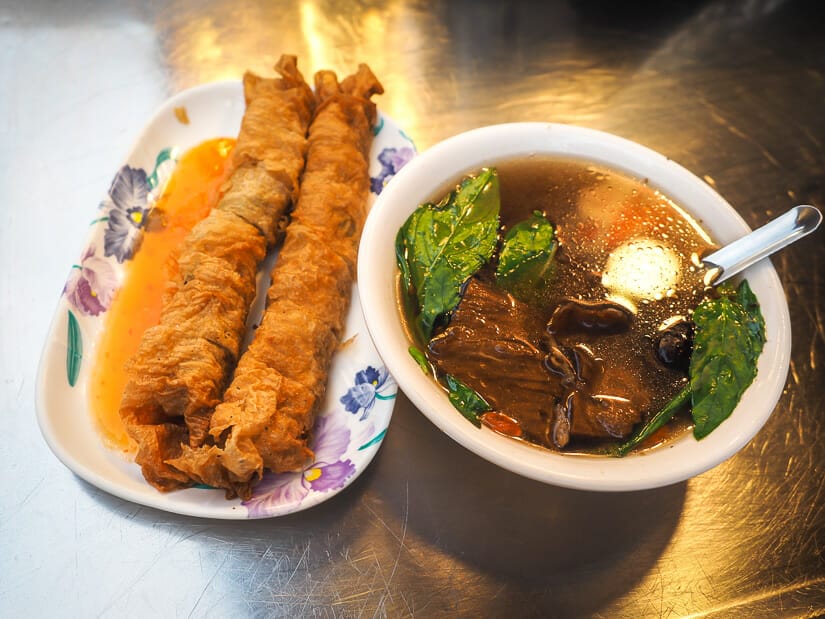
A few stalls down from the crab stall, and on the same side, this stall serves the best vegetarian food in Keelung Night Market, all of it very traditional. Look for the words vegetarian food (素食) on the sign and the large steaming vat of luwei (soy braised items) beside the stall, including vegetarian version of blood rice cakes and other items that aren’t usually vegetarian.
Besides the stall’s signature eight treasure noodles (八寶冬粉), they also have dang gui soup (當歸湯, a kind of herbal soup, pictured above) and sticky rice rolls (糯米卷 or nuomi juan, also pictured above), a vegetarian version of the chicken rolls sold from stall #15 I described above.
Cheng Ji Spare Ribs (鄭記排骨)
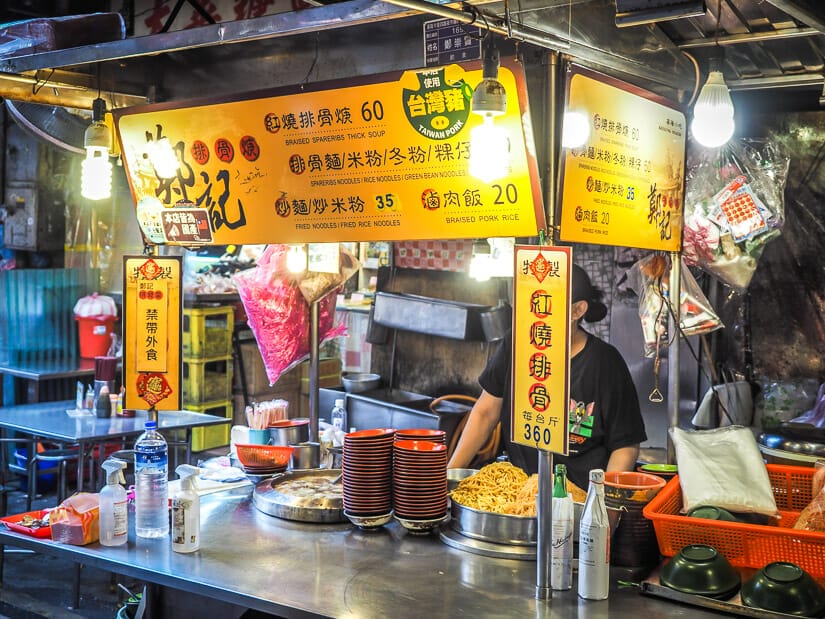
About halfway up Aisi Road, again on the left side, is this spare rib soup stall. The ribs are served in a meaty, herbal brother or with noodles (both NT 60). As a pescatarian, I can’t speak to how delicious it is, but the stall is very popular among Taiwanese.
The dish is similar to some extremely popular rib soup vendors in Taipei night markets, including ones at Shilin, Yansan, and Raohe Night Markets. All three are officially recommended in the Taipei Michelin Guide. You can find the names of them in my Taipei night market guide.
Zhenji Unagi (圳記紅燒鰻)
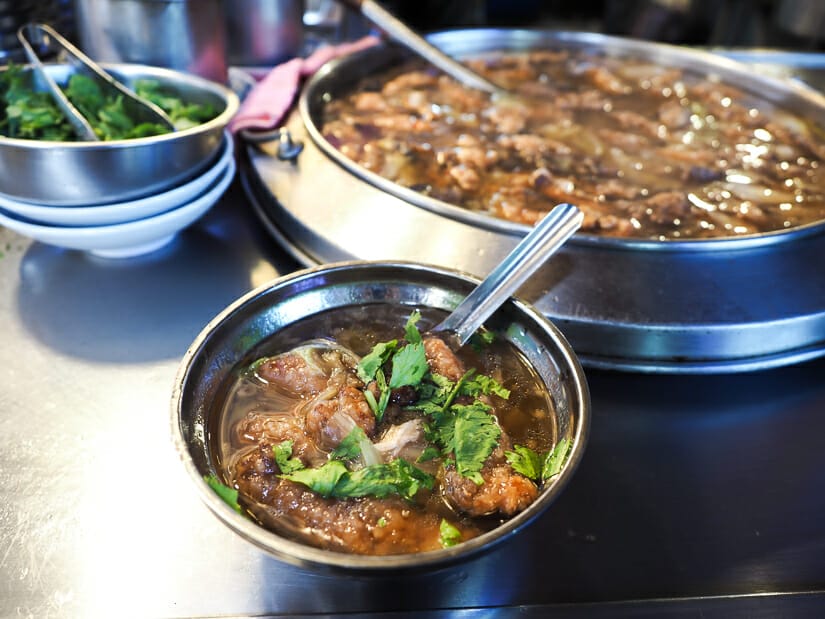
Eel is a dish that is more common in southern Taiwan (see where to eat it in my guides to Tainan’s night markets and Kaohsiung’s night markets), where it is often eaten with noodles. Here at Keelung Night Market you can enjoy pieces of braised eel in a fragrant soup garnished with cilantro.
The dish is a little pricey, at TWD 90 for a small bowl, but I can attest that it’s really good. The stall is directly opposite Cheng Ji Spare Ribs.
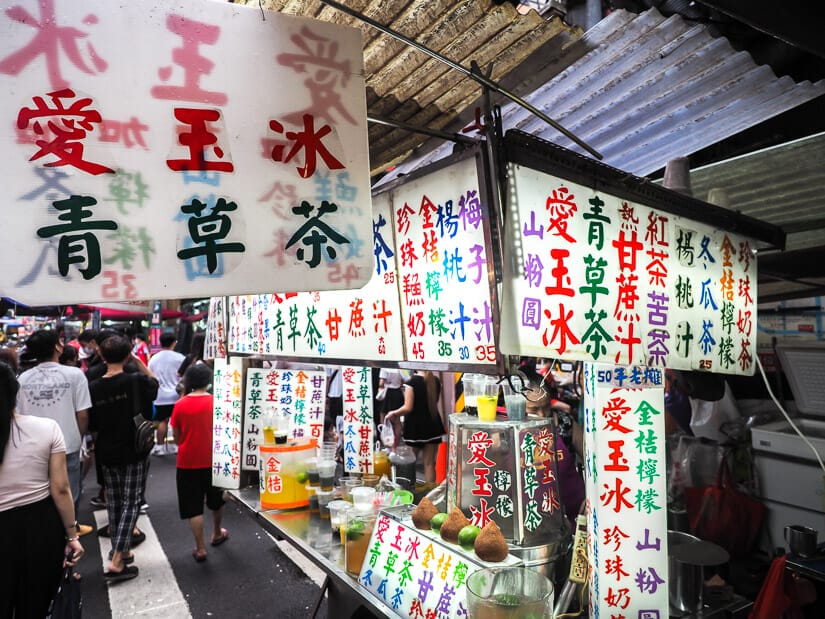
Other Things to Do around Keelung Night Market
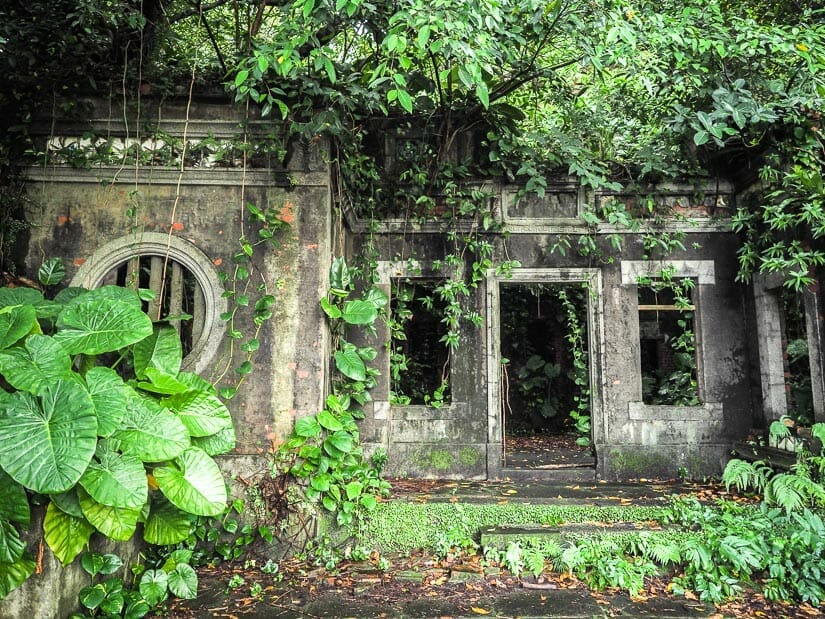
While Keelung’s night market is the big draw, there are several other things to do in town. Even if you’re mainly just visiting the market, make sure to stroll through Maritime Plaza on the way back to the train station. It has a good view of Keelung Harbor and is especially romantic when things are lit up at night.
I also recommend walking up to the ruins of Khóo Tsú-song Old Mansion (許梓桑古厝). The path is only two minutes away from Keelung Night Market – to find it, hang a right on Aisi Road and watch for the narrow staircase on the south side of the street.
Here are many more things to do in Keelung, enough to fill a whole day! (article coming soon)

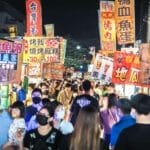

Hi Nick! Awesome site! How late do trains / MRT / buses run around Taipei? Can I reliably return to my hostel in Taipei very late at night after nom noming on delicious food at night markets around Taipei and as far away as Keelung? Also by the way, what are the best ways to get Taiwanese cash? Obtain from home bank before flying? Exchange at airport (do they accept only accept certain currencies / denominations)? Debit/credit cards at ATMs? Thanks!
I think I may have already responded to your question in my FB group, but I’ll reply here too. Trains from Keelung back to Taipei go till around 11. In Taipei, the last trains set out from their starting stations at midnight, reaching their final stations around 1-1:30 am. As for cash, I personally always just bring my foreign debit card and withdraw cash from ATMs in Taiwan. They are everywhere, and the withdrawl limit is pretty high. You may want to notify your bank that you are going to travel so they don’t freeze your card, and also find out what you own bank’s withdrawal limit is. I don’t usually exchange cash before or after my trip because it’s more of a hassle, and you lose more on the exchange rates.
Going to Taipei around March 9 nyour article is awesome
Will try this night mkt